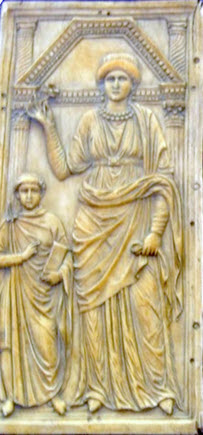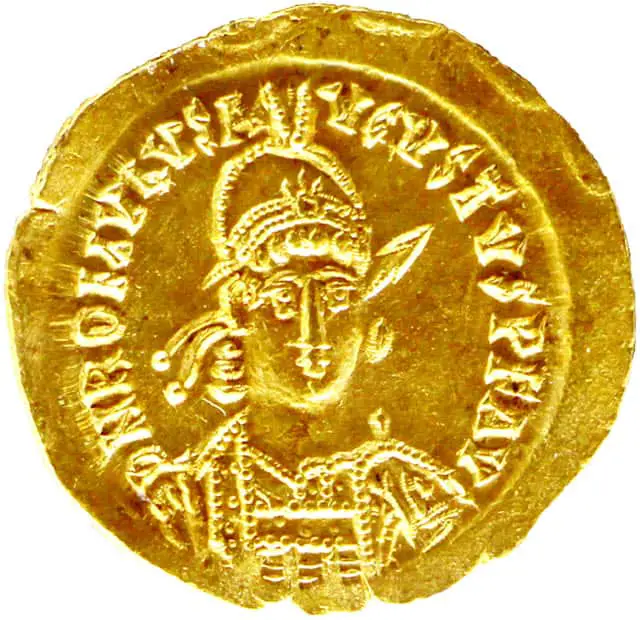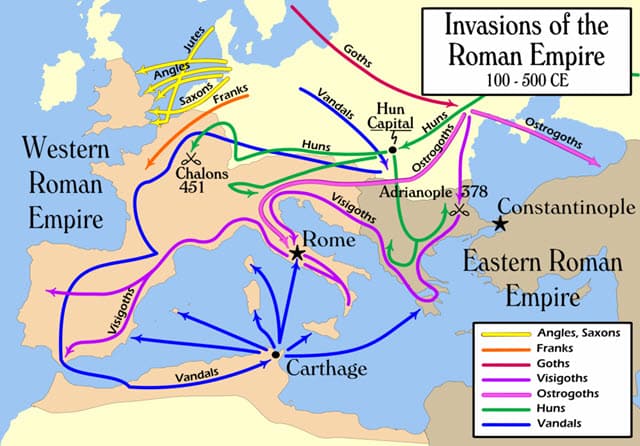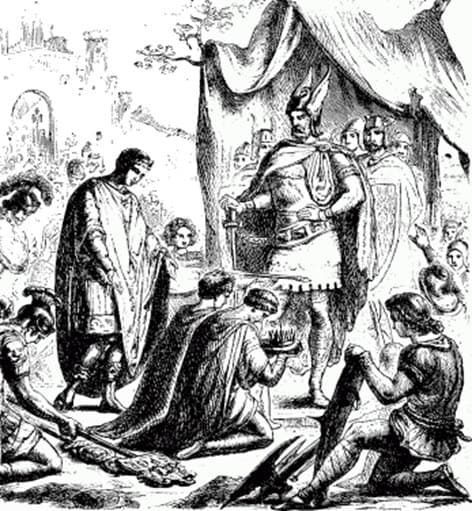Romulus Augustulus, Flavius Momyllus Romulus Augustulus, was the last Western Roman emperor or Roman Emperor overall. He reigned from 31 October 475 until 4 September 476.
Born in 461 AD, he was named Romulus after his maternal grandfather. He bore the names of the first King of Rome – Romulus, and the first Emperor of Rome – Augustus.
During his 10 months of reign, Romulus impacted Romans with numerous contributions and inventions. One of the most famous contributions was the construction of the Capitol Building in Washington.
However, he was not considered the perfect emperor for Rome, despite his contributions to Rome.
This article discusses the life of the last Emperor of Rome, particularly of the Western Roman Empire.
1. Did Romulus have any siblings?
Content
It was customary in ancient Rome to name one’s eldest son after his father. Romulus was not named Tantalus (the father of Orestes, an officer in Pannonia), which indicates that he was not born first.
2. Why didn’t the Orestes take the imperial throne?
Orestes was waiting for official recognition or response from Zeno in the east. The answer never came, as those in the eastern Empire did not consider Romulus the legitimate ruler.
4. Was Orestes familiar with Odoacer?
Orestes once worked at Attila’s court alongside Edeko, the father of Odoacer.
Family

Orestes, the father of Romulus, was a Roman aristocrat and political leader of the western Roman army from AD 474. Romulus’ mother, Flavia Serena, was the daughter of an aristocrat, Count Romulus of Passau.
The predecessor of Romulus, Julius Nepos, became emperor of the western Roman Empire in June AD 474. The eastern emperors, Leo I (r. 457–474) and Zeno (r. 474–491) appointed Nepos as the western emperor.
After some time of Nepos’s rule, he appointed Romulus’ father, Orestes, as the West Roman army’s master of soldiers.
On 28 August 475, shortly after Oreste’s appointment, he launched a revolt against Julius Nepos and gained control of Ravenna, the Western Roman Empire’s capital since 402.
After Nepos’ deposition, he fled to Dalmatia, where his uncle had ruled a semi-autonomous kingdom in the 460s.
However, Orestes refused to be emperor for some secret motive, according to the historian Edward Gibbon. Therefore, he crowned his son Romulus as emperor of the west.
Early life and reign

Romulus’ life is sparsely described in history. Considering his father’s prominence in government, Romulus received a formal education similar to what was offered to aristocratic boys at the time.
When he became emperor, he was still a minor, perhaps as young as fourteen, with minimal administrative and political knowledge.
Despite Augustus taking the title “Augustus” as his name, he was famous as Augustulus, “the little Augustus” in the western Empire.
Orestes took over the priority and power for himself and made his son Augustulus emperor in Ravenna, but he handled all external affairs himself.
His father appointed Romulus made no decisions in any field and left no traces of monuments in history. However, few coins bearing his name were found in Rome, Ravenna, Milan, and Gaul.
Romulus’s active participation and contribution were absent in political and administrative work, as he was considered too young to rule according to his laws and policies.
Zeno never recognized Romulus’s rule as emperor in the west because Nepos had been crowned with Zeno’s predecessor, Leo I, while Romulus was a young emperor.
The public mocked Romulus’s imperial name. Many referred to him as ‘Momyllus,’ meaning ‘little disgrace.’ This suggests that few recognized Romulus as their legitimate ruler.
Fall of reign

The Empire declined for several reasons, and some of the cases occurred within the Empire. Due to wars and overspending, there was a severe financial crisis and inflation. Here are a few reasons for the decline in reign.
Problems with the economy and overdependence on slave labor
A severe financial crisis was also causing Rome to crumble from within. From the outside and from within, the city was under attack.
In addition to constant foreign wars and overspending, oppressive taxes and inflation widened the difference between the rich and the poor.
Several wealthy families fled to the countryside in hopes of avoiding the taxman.
As Rome’s economy was based on slaves, a labor shortage rocked the Empire. The Empire began to lose its grip on Europe as its economy faltered and its agricultural and commercial production declined.
The rise of the Eastern Empire
By the end of the third century, Emperor Diocletian divided the Roman Empire in half-the Western Empire residing in Milan and the Eastern Empire in Byzantium, later known as Constantinople.
Divided empires made governing easier in the short term, but the two halves grew apart over time. It was difficult for East and West to work together effectively and often argued over resources and military aid when dealing with outside threats.
As a result, the Eastern Empire, largely Greek-speaking, grew in wealth, the Latin-speaking West went into an economic crisis.
Most importantly, as the Eastern Empire grew, it became wealthier and more substantial, which diverted Barbarian invasions away from the east.
Over expansion of territory
When the Roman Empire was at its peak, it extended from the Atlantic Ocean to the Euphrates in the Middle East. The Empire faced an administrative and logistical nightmare because it had a large area to govern.
It was difficult for Rome to gather enough troops and resources to defend its borders against local revolts and outside attacks.
Technology advancement slowed as more funds were funneled into military upkeep, and Rome’s civil infrastructure fell into disrepair.
Government corruption and political instability
A large city like Rome is difficult to govern, but ineffective and inconsistent leadership increases the difficulty. Political corruption and incompetence were also widespread in the Roman Senate.
As the situation worsened, civic pride waned, and many Roman citizens lost trust in the government.
Invasions by Barbarian tribes
However, the primary reason for the decline of Roman rule occurred under Romulus. Many problems arose within several months of Orestes taking power.
Due to the Western Roman army, many issues arose, made up primarily of barbarian foederati. A severe problem was managing the diverse barbarian troops putatively under his command.
In 476, various barbarian foederati demanded land in Italy to settle. These barbarians primarily included the Hercules, Sirians, and Turcilingians. It was because Orestes refused the request for land that the reign of King Romulus began to crumble.
The soldiers turned to Odoacer, a barbarian chieftain from a Hunnish and Scirian background, to help them, where Odovacer promised to grant their requests if they made him king.
Under the leadership of Odoacer, these troops marched across the Italian border in August AD 476 and rebelled against the western emperor.
In August 476, Orestes was captured and killed near Piacenza. A month later, Odoacer successfully deposed Romulus. After nearly 500 years of flourishing, the Roman Empire fell, and the western Empire dissolved.
Deposition of Romulus Augustus

Romulus, however, was spared because he was still young; Romulus was compelled to leave the throne on 4 September 476.
Moreover, the Byzantine historian Malchus suggests that Romulus must perform one final official act before stepping into retirement.
Romulus was asked to dispatch a “letter of resignation” to Zeno’s eastern emperor. He returned the imperial regalia and said that the Empire needed a single emperor in Constantinople.
Later, Odovacar was chosen as a suitable man to safeguard the affairs, considering that he had better political understanding and military skill after the decision was made to grant Odovacar the patrician honor and grant him the government of Italy’s.
A little over ten months into his reign, Romulus lost his throne. This signified the end of the rule of the emperors in the west, and the break-up of the western Empire, although Romulus’ deposition did not cause any significant disruption at the time.
Later Life
The young Emperor was spared, and in addition to that, Romulus was given an annual pension of 6,000 solidi (equivalent to the average income of a wealthy Roman senator).
In Campania, near Naples, an estate called Castellum Lucullanum (known today as Castel dell ‘Ovo) was given to him and his companions. The castle was initially built by the consul and general Lucius Licinius Lucullus in the 60s BC.
It is believed that the castellum Lucullanum was a fortified city that served as an administrative and military center in Campania. Romulus was accompanied in Campania by his surviving relatives and a large entourage.
Romulus seems to have built an essential monastery at Lucullanum around the remains of St. Severinus, possibly dating back to the 480s or early 490s.
Barbara, a noblewoman, probably his mother, also played a crucial role in setting up the religious house. It rose to prominence under Gregory I and remained in use until the tenth century.
Later in 493 and 507 (or 511), Romulus had to resettle his financial arrangements with the government of king Theodoric.
Legacy
Having been portrayed several times in both film and literature, Romulus was the last Western Roman emperor before the traditionally agreed-upon end of the Western Roman Empire (however, the Roman Empire in the east continued to exist for another 1000 years).
Though the western empires fell, the rulers of the west left behind a significant legacy in the following sectors.
Government
The Roman Republic laid the foundation for concepts such as power balance, veto, and representation, which modern governments still use today.
Law
Several modern-day laws of many countries can be traced back to Roman rule. Several legal concepts, such as trial by jury, civil rights, contracts, personal property, legal wills, and corporations, are derived from Roman law and government.
Architecture
Ancient Rome’s buildings and architecture are still evident in many government buildings, large banks, and even prominent buildings, such as the Capitol Building in Washington.
Language
During the Roman Empire, Latin was spoken throughout much of Western Europe. Several languages have evolved from Latin, now spoken by more than 800 million people worldwide, including French, Spanish, Portuguese, Italian, and Romanian.
Therefore, the deposition of Romulus is also regarded as one of the most significant dates in marking the transition from antiquity to the medieval period.
